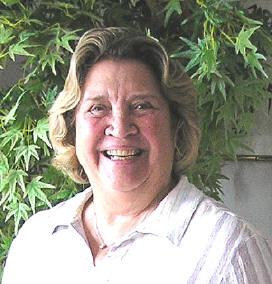Carol Sieck
Adams County Master Gardener
 This article is timed to give you a chance to plan for your enhanced fall landscape. Now that July 4th is past, we are halfway to Labor Day - and the unofficial end of summer. That means it is time to think about the fall burst of color that you'll
want to add to the fading summer color remaining in your garden.
This article is timed to give you a chance to plan for your enhanced fall landscape. Now that July 4th is past, we are halfway to Labor Day - and the unofficial end of summer. That means it is time to think about the fall burst of color that you'll
want to add to the fading summer color remaining in your garden.
The term "hardy" defines plants that grow in a higher growth zone; these specimens are cultivated from places like China, Japan, Russia and even the Arctic. Two of these hardy bloomers are my favorites, the hardy hibiscus which blooms in the
midsummer, and hardy chrysanthemums that bloom in the fall for a final explosion of color before the frost hits. We affectionately call this last flower "the mum".
The C. rubellum group of chrysanthemums includes the hardy mum which blooms in the late summer; it is a herbaceous perennial meaning it has a somewhat woody base which becomes thicker as it ages. The hardy mum can winter in zones 5-9. The leaves are
soft and often long with many indentations and rounded irregularly shaped lobes. Sometimes there is a silvery cast to the leaf and often they have a feathery feel to the touch. The plant is bushy with lots of stems branching out, usually reaching from 2 to 5 feet high.
Because of this height, it helps to stake the branches of taller plants so the blooms can be seen to their best advantage.
The colors range in every hue except blue and come in many shapes. There are large single pompoms that were worn at football games years ago and now used in elegant floral displays. There are small clusters of pompoms, rosette shapes, and spider mums
with long flowing petals. The most commonly seen mum is the daisy petal, with a center disc that is yellow. This daisy-looking mum can be a single circle of petals around the disc, or a double layer of petals, called a semi-double.
Annual chrysanthemums originate in sunny fields of their Mediterranean homeland. They are included in the same major grouping (Asteraceae) as the hardy mums. Both the hardy and the annual mums are related to the Aster family (Asteraceae) and are
often grown together as complimentary plantings. Pots of mums are sold in the late summer for fall color. Generally, the annual mum does not survive our winters.
Planting instructions are the same as with most other small plants - prepare the hole with some compost in a sunny, well-drained location. To remove the plant, gently tap the base of the pot, turn it upside down and tap again until the plant begins
to slip away from the pot. Loosen roots with your fingers by gently pulling them apart so they can grow in their new location. Guide the plant and soil into the hole, press around the base to expel air holes; water and then fertilize lightly. Make sure the soil is moist and
fertilize lightly and often until the plant is ready to bloom. Chrysanthemums require frequent feeding because they bloom so heavily.
Now tap your creativity as you take an active part in how the plant displays its blooms. Mums will grow all summer without attention except staking, then they just bloom naturally. Or, as they bud, tall stems can be disbudded by pinching off many or
most of the little buds before blooming so you have one or two larger blooms on each stem.
For more blooms, the stems can be pinched off earlier as the new growth tips each stem, encouraging more lateral growth and therefore more blooms. This pinching of the stem can be done even a second time to produce smaller blooms on each stem.
Pinching should be discontinued by mid-July so that the plant can prepare for its fall display. Mums allow you to add color to your late summer or early fall garden. Whether you ignore them or by work with them, the plants will surely add to your fall enjoyment.
Like many other perennials, chrysanthemums need attention after they bloom and before winter arrives. If they are located in a windy, open space, apply a thick mulch cover in the very late fall, cut back the stems and let them rest for the winter.
Florists have long relied on chrysanthemums because of their long life span when cut - a two week life span for an arrangement is appreciated by both the one who creates the arrangement as well as the one who receives the arrangement. There are
exhibition cultivars with a 12" flower head - good for large arrangements displayed in hotels and dining rooms. The backyard gardener also enjoys the long life of the blooms in the home garden. The plants can make wonderful borders, displaying color after most other flowers
have passed their prime. Finally, after all your work, sit back and enjoy this final burst of color in your flower garden.
Read other articles on garden and landscape design
Read other articles on plants and gardens
Read other fall related gardening articles